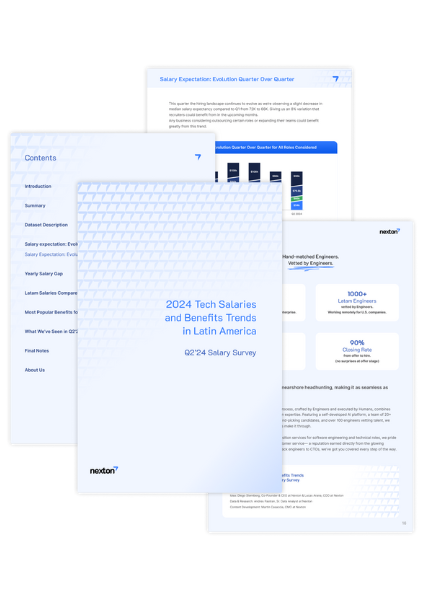Finding the perfect talent for your project is no easy feat. Despite developers being a scarce resource, there are thousands of top-notch remote candidates and many hiring options that may suit your company's needs – if you know where to look and what your options are. To get the best engineering talent, you’re likely deciding between building your own in-house team or outsourcing your project.
Let’s take a deep dive into building your own team vs. outsourcing so that you can choose what suits you best.
Ready to hire senior engineer talent in LATAM? Learn more about our specialized Headhunting and Hiring & Payroll Processing services at Nexton.
Contents:
- What are the benefits of hiring engineers in Latin America?
- When to outsource your tech needs?
- How to outsource your tech needs?
- When to build your own in-house team?
- How to build your own in-house team
- Summary: Decision tree for building your own team or outsourcing
- Leverage Headhunting or Hiring & Payroll Processing services with Nexton
What are the benefits of hiring engineers in Latin America?
Highly skilled developers are a very scarce resource in many parts of the world, and the U.S. is no different. To meet their tech needs and build top-tier teams, businesses may need to expand beyond borders and leverage global talent. In particular, hiring in Latin America offers an exciting opportunity as it has sophisticated engineers with specialized skills, remote experience, and English proficiency – all within nearshore time zones and for affordable rates.
However, finding tech talent in LATAM may be challenging without knowing the local languages, leading companies, university programs, industry platforms, and salary expectations in the region. Without these points of reference, it’s tough to find and retain engineering talent.
For this reason, you need a talent partner like Nexton who knows your needs and works to guarantee the success of your talent search and retention, while also saving you time and money.

When to outsource your tech needs?
Of course, building your own remote team isn’t the only option. Some companies may instead work with professionals on a specific project or for short-term needs on a scaling team.
While businesses don’t have full control of the engineer’s time and pay in the outsourcing model, it can be more cost-effective. It also allows companies to stay flexible as they build products and delay defining their long-term needs until later on.
How to outsource your tech needs
There are two options for outsourcing your development needs: staff augmentation or project outsourcing. Both of these models mean that you lose significant control of the project in exchange for highly flexible and scalable partnerships.
Option #1: Staff augmentation
Staff augmentation is often defined as filling gaps on your in-house team. Typically, you’ll work with an agency that sells you development hours for a specific project.
In this model, you don’t get visibility into the developer’s skills, time or pay. This means you depend on the quality of the agency and its expertise. In this case, it’s more difficult to build a close relationship with developers or incorporate them into your company culture.
The agency also acts as a buffer between you and the engineers, in some cases managing their time and priorities with other clients. This can lead to less effective communication and efficiency in the long term. That said, staff augmentation may be right for companies that require the manpower to scale their projects quickly, but aren’t as concerned with building long-term teams. Here are a few reasons why companies choose staff augmentation:
- It’s cost-effective.
- It’s scalable according to your needs.
- It’s good for short-term or temporary talent gaps.
- It’s a good fit if you are building a product that isn’t your core business.
The disadvantages of staff augmentation
It’s important to note that not all talent agencies are created equal. In fact, they tend to have a bad rap, which is why companies may be hesitant to try them out – and the best developers may be wary of working with them. Here are some downsides of choosing substandard agencies:
- Lack of transparency into salary and benefits: Some agencies put up a wall between you and the remote talent. In this case, you won’t have insight into how much the team members are actually earning and receiving in benefits, making it difficult to negotiate and offer competitive packages. What happens if one of your critical engineers asks for a raise? Often companies lose them and have to deal with onboarding new talent through the agency.
- Lack of company cultural feel and branding: When team members mainly interact with the agency instead of you, they’ll lack the cultural feel and branding of your actual company. This can make it challenging to incorporate talent into your teams and expose them to the positive experience of your corporate culture. In the end, they are not entirely part of your team. At the same time, agency engineers are allowed to move on to a different project at any point. Ultimately, there’s no strong affiliation with your company.
- Lack of insight into team member satisfaction: It’s also common for companies to experience high worker turnover through staff augmentation agencies, as they’re unable to take the pulse on workers’ satisfaction with their salary, benefits, company culture, etc.
- Lack of participation in the recruiting process: Companies who choose agencies may struggle to communicate directly with developers, as the agency will not offer the chance to interview them and serve as a filter for communications. Having a proxy like this can slow down communication and isolate them.
- Lack of specialized skill tests: Some agencies may also lack tech industry know-how, as they handle recruitment for a wide range of roles. This isn’t ideal for tech companies that require specialized skill tests or challenges to check candidates' qualifications.
- Rush to fill positions due to competitive industry: Finally, the staffing and recruitment industry is highly competitive, and some agencies will try to fill positions as quickly as possible – instead of finding the right fit for your company’s needs.
While staff augmentation can be an advantageous option for companies, it’s essential to seek out highly proficient agencies that give you transparent insight into your hires and allow you to engage with them directly.

Option #2: Project outsourcing
Project outsourcing is another option for companies who want to go completely hands-off with their tech needs and simply outsource the project (or part of it) to an agency that commits to building the end product.
While you don’t have to worry about managing the project, this model can be high-risk, as it depends on the responsibility and professionality of the outsourced agency. It also tends to be pricier due to the overhead of a full-scale partner.
Here are a few reasons why companies choose project outsourcing:
- It’s more hands-off, so you can focus on other business needs. Remember that building products these days is an iterative process. You always want to be interacting with the team on a regular basis to provide feedback.
- It can be scalable with the right partner.
- It’s ideal when you don’t have the time or expertise to have an in-house development team.
Ultimately, outsourcing options may be right for companies who prioritize speed and scalability above all but are not looking to build company culture with this part of the engineering team. What’s more, outsourcing can be useful when your team doesn’t yet have the expertise or capital to form an in-house team.
When to build your own in-house team?
Businesses that want to build their own teams are often looking for ongoing, long-term talent in order to fill a specific role and have full control of the individual’s time and priorities. Overall, this is beneficial for:
- Building deeper relationships with the talent.
- Incorporating team members into your company culture: Teams that are surrounded by peers while being immersed in a winning culture, have a greater sense of ownership and go the extra mile to achieve a difference for the end-users.
- Enhancing the project quality through in-house cohesion, which translates into end-to-end product development cycle ownership by your mission-driven technical team.
- Controlling product development processes.
- Growing and maintaining your main product lines.
While building your own team can be more time-consuming, companies often choose to build in-house talent to create and maintain their flagship products with 100% control..jpg?width=6144&name=young-asia-businesswoman-using-laptop-talk-colleague-about-plan-video-call-meeting-while-work-from-home-living-room%20(2).jpg)
How to build your own in-house team
You have two excellent choices for building your own in-house team remotely: Headhunting or Hiring & Payroll Processing. Let’s take an in-depth look at both options, so you can choose the service that meets your long-term needs and goals.
Option #1: Headhunting
Headhunting services are focused on capturing key talent, but let you handle the rest of the logistics on your own. Ultimately, headhunting is a top-notch idea if your company is trying to recruit specialized long-term talent, but doesn’t need help with the logistics of hiring and payroll processing. Here are the benefits of choosing headhunting services:
1. Specialized recruitment skills to find the top candidates for specific roles.
Headhunters have specialized recruitment skills and are seasoned professionals in finding talent through their industry-specific networks and databases. Headhunters are laser-focused on getting top-tier senior candidates for your open role and use their own proactive approach and tools to discover them.
2. Screening tech qualifications according to your tech needs.
Unlike other services, technical headhunters have a deep understanding of the tech industry and know how to screen candidate qualifications to ensure they have the senior tech skills required for the role. Some agencies may even use an extra layer of screening through peer-to-peer interviews.
3. Cost-benefit of a one-time finder’s fee, instead of ongoing hiring expenses.
Headhunting services connect you with and screen the talent you need – and let you take it from there. In this case, you’ll only be paying the finder’s fee and not ongoing costs related to hiring or payroll processing. For companies that already have a remote hiring process in place, headhunters offer a cost-effective alternative.
Our specialized agency connects you with the ideal candidates for your tech roles. Learn more about our headhunting services at Nexton.
Option #2: Hiring & Payroll Processing
On the other hand, Hiring & Payroll Processing is another great choice for companies who are looking for long-term international team members and need support not just in finding talent, but also in handling all of the logistics that come with having an international team. Here are the main advantages of using Hiring & Payroll Processing services:
1. End-to-end worry-free solution.
Companies often want to take advantage of global talent without the headache of the liability of having an international team member. Hiring & Payroll Processing services provide these much-needed services, including recruitment, hiring logistics and ongoing payroll. This allows companies to focus on their core business and leave these end-to-end logistics to the pros.
2. Clear insight and control over salary and benefits to retain top talent.
Hiring & Payroll Processing services help you offer competitive job packages and boost team members’ satisfaction. They do this by giving you control over the salary and benefits of each team member, so you can easily negotiate compensation as needed. It also helps companies retain top talent, as the service provider will ensure the worker is satisfied with the payroll arrangements and benefits.
3. Long-term fit for roles through specialized skill tests and company cultural interviews.
In addition, these services focus on directly integrating workers into your company’s culture, as it’s essential for remote talent to be part of the team. Effective Hiring & Payroll Processing services place their client company’s branding and culture first – starting during the recruitment phase. They’ll look for remote long-term candidates by checking for cultural fit, as well as performing skill tests or technical peer-to-peer interviews.
Our services provide end-to-end hiring, so you can enhance your tech team without the stress. Find out more about our Hiring & Payroll Processing services at Nexton.
Summary: Decision tree for building your own team or outsourcing
You can use the following decision tree to choose the best option for your needs!
.jpg?width=2316&name=Group%2034%20(1).jpg)
Leverage Headhunting or Hiring & Payroll Processing services with Nexton
Depending on your company’s tech needs, any of these options above may be suitable. For long-term teams, Headhunting or Hiring & Payroll Processing services are the top choices.
Fortunately, Nexton is your one-stop shop for LATAM tech recruitment, as we offer both Headhunting and Hiring & Payroll Processing services. We specialize in recruiting senior tech professionals and provide full-scale, transparent payroll services to make it easy for you to leverage remote engineering talent on your own terms.
Interested in learning more about Nexton’s end-to-end services? Reach out to us at contact@nextonlabs.com


